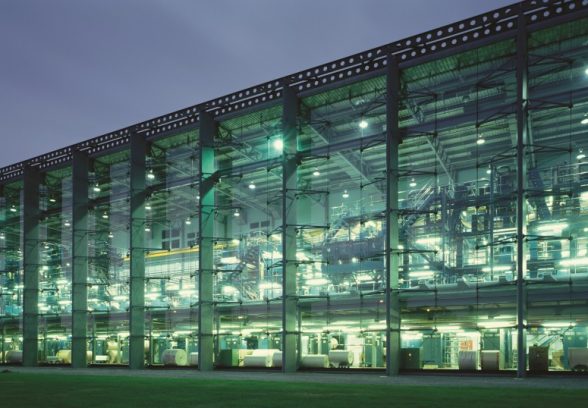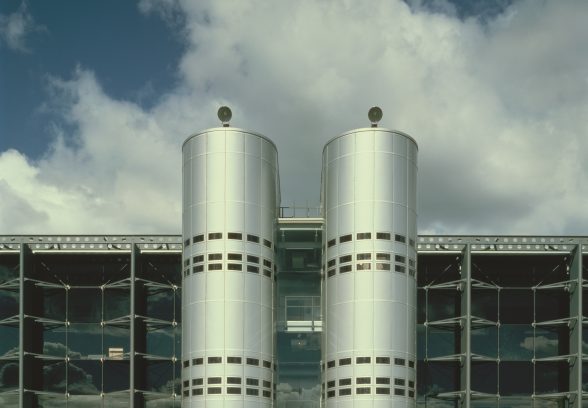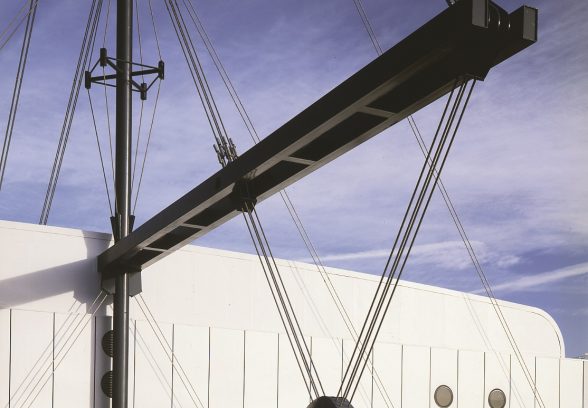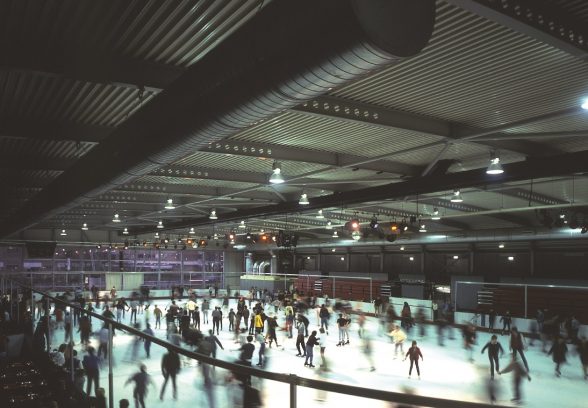This website uses cookies
This website uses cookies to enable it to function properly and to analyse how the website is used. Please click 'Close' to accept and continue using the website.






The Twentieth Century Society is calling for the protection of two key 1980s ‘High-Tech’ buildings, designed by Grimshaw and Partners – the former Financial Times printworks, and the Oxford Ice Rink. Both were designed to present the spectacle of their kinetic uses (circling skaters and rotating printers) to passing viewers and are fantastic examples of High-Tech industrial architecture.
The former Financial Times printworks in London’s Poplar was built in 1988 with an innovative structural glazing system designed to allow uninterrupted views into the giant printing press machinery – particularly impressive at night when the whole building was lit up.
Winner of several design awards, it was praised at the time for completely transforming the standard ‘shed’ design of other printworks that were constructed at that time, as the national broadsheets moved out of their traditional Fleet Street home to cheaper accommodation in east London. Built in just 12 months, it was designed to have a fully flexible interior and was also critical for proving to clients that exemplary industrial design was achievable on a tight budget.
The building, which is now used as a data storage centre, is currently under assessment for a ‘Certificate of Immunity from Listing’ which, if granted, would mean no listing applications could be considered for five years.
We are also strongly backing the listing of the Oxford Ice Rink. Built in 1984, it was one of Sir Nicholas Grimshaw’s first major commissions after leaving his partnership with Terry Farrell. The most striking feature of this ship-like building is a pair of tall masts driven into the ground, part of a structurally innovative design approach.
An ice rink requires a large, centralised column-free space, and to achieve this, a spine beam formed from a pair of rectangular box sections, runs the full length of the building and supports the ice rink. This beam is ‘hung’ from two 30m high masts at either end of the building. Visible at a distance from Oxford City Centre, these masts are described by Grimshaw as forming “a contemporary foil to the city’s famous spires.”
Like the FT building, it features a glazed elevation. The north facing wall allows skaters to imagine they are outside, and at night the building is turned into a spectacle. This was an unprecedented design feature, as traditionally ice-rinks were shed like – with no external openings that would allow the sun to melt the ice.
The listing application for the Oxford Ice Rink was submitted earlier this year in response to a potential threat from a proposed housing scheme which could see the building redeveloped.
Henrietta Billings, Senior Conservation Adviser, Twentieth Century Society said: “Both of these buildings are outstanding examples of Grimshaw’s innovative and pioneering approach to industrial design. They set new standards and expectations about design quality, and were proof that you could have a beautifully crafted, flexible building on a constrained budget. Their contribution to 1980s High-Tech design deserves protection and recognition through listing.”
Sir Nicholas Grimshaw (b 1939) is considered one of the most significant contemporary British architects and a pioneer of High- Tech architecture. He was appointed a CBE following his designs for the British Pavilion for Expo 92 in Seville, and other notable buildings include the International Terminal at Waterloo Station, which won the RIBA Building of the Year award, and the Eden Project in Cornwall.
Grimshaw’s work is receiving increasing critical acclaim. His factory building for Herman Miller, Bath (1976-7) was listed grade II recently and a block of flats by Farrell/Grimshaw Partnership for Mercury Housing Society Limited in Westminster is listed at Grade II. His work at Paddington Station, London (listed Grade I) is noted in the list entry, and at our instigation, his former Western Morning News building was listed at grade II* in 2015.

Become a C20 member today and help save our modern design heritage.